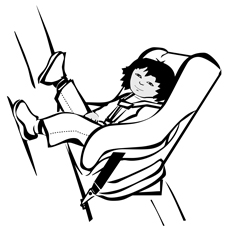 Printable Version
Printable Version
A rear-facing seat provides the best protection for a child's head, neck and back in a sudden stop or crash. Using a car seat properly is required by law in Alberta. Use the YES test to help you properly install the care seat in your vehicle and buckle up your child correctly every time.
Push, pull and adjust the seat until you can check each item that applies to your child's car seat.
Who should be in a rear-facing car seat?
- A child is safest in a rear-facing car seat until they are at least 2 years old or reach the maximum weight or height limit for the rear-facing seat (as stated by the manufacturer).
- Rear-facing car seats that have higher weight and height limits are preferred and will keep your child in the safer, rear-facing position beyond age 2.
Getting ready
- I’ve read the instruction booklet that came with the car seat.
- I’ve read my vehicle owner’s manual on how to install a car seat.
- I’ve checked the labels on the seat to find the maximum rear-facing weight and height limits. My child’s weight and height are under the limits.
- My child’s car seat is in the back seat.
- I never place the car seat in front of an airbag.
- My child’s car seat is approved to be used in Canada and has a CMVSS label.
Securing the car seat
There are 2 ways to secure the car seat.
Either:
-
I'm using the Universal Anchorage System (UAS) to secure the car seat.
- I've checked my vehicle owner's manual for the correct UAS anchor locations.
- The UAS belt goes through the
rear-facing belt path on the car seat or base and is attached to the UAS anchors.
OR
-
I'm using the seat belt to secure the car seat.
- I've checked my vehicle owner's manual for how to lock the seat belt for use with a car seat.
- The seat belt goes through the
rear-facing belt path on the car seat or base and is buckled up.
- If the seat belt doesn't lock, I've used a belt lock or locking clip.
For either UAS or seat belt installation:
- I've pushed down on the car seat or base and pulled the UAS belt or seat belt tight.
- The car seat moves less than 2.5 cm (1 inch) in any direction.
Buckling your child in the car seat
- The slots the harness straps go through are at or just below my child’s shoulders.
- The chest clip is at the level of my child’s armpits.
- The shoulder harness lies flat with no twists.
- The harness is snug—I can’t pinch a fold in the harness strap.
Being safe
- My child rides in the car seat every trip.
- If the car seat has a carry handle, I put it in the travel position.
- I’ve sent in the registration card and checked for recalls on my child’s car seat. Recall information is available from Transport Canada at 1-800-333-0510 or at
www.tc.gc.ca/roadsafety/ (search for child safety).
- If needed, I’ll get a larger car seat, with higher rear-facing height and weight limits, so I can keep my child rear-facing as long as possible.
- When my child outgrows the rear-facing seat, I’ll move them to a forward-facing car seat.

Q: My child's knees are bent, is it still safe to use a rear-facing car seat?
A: Yes, injuries to the legs are very rare when children ride in rear-facing seats.
If you answered “YES” to all of the statements, you’re ready for travel! If not, check the instruction booklet for your car seat as well as your vehicle’s owners manual for the exact installation instructions.
For more information:
